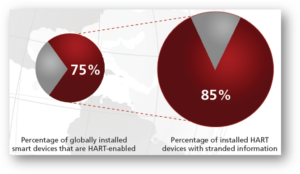Using Industrial Wireless Technology to move from the Edge to the Insight
Human beings are smart and social creatures. We all have our talents and like to be able to share them and our knowledge with our friends and colleges. Many times, however, we are placed in situations where we have valuable input to give, but we are unable to get our knowledge or ideas across. How many times, at a trivia night, for example, have you had the answer, but been unable to communicate it?
The instrumentation on the vast majority of processing plants in operation today has the same issue with valuable data. Modern instruments are smart devices, being able to make multiple measurements and have a vast array of on-board diagnostics. Take your Coriolis flowmeter for example. It can simultaneously measure mass flow, volume flow, density, temperature, and flow totals.
While the instruments used in your process are smart and have all this data available, unfortunately for most of them, they can’t communicate this data to the upper level systems. Their valuable data is stranded.
HART devices and valuable data

The main reason why we are unable to receive this extra process information is because of legacy control systems. Many control systems today have been operating for a long period of time and don’t have the capabilities to accept this valuable data that is available from your instruments via HART.
How could you integrate the stranded data?
There are two solutions that you could employ to fix such a situation. The first solution is to replace your legacy control system with a new, HART enabled system. Unfortunately for most, this solution is cost prohibitive, and is also a long-term approach. It requires new hardware, new engineering, and project management to implement. A significant investment in the plant is needed, which if often hard to justify in an older facility.
Accessing the stranded data can positively impact your plant operation today, giving benefits that can help achieve improved operations, improved quality, and lower environmental impacts. You need to achieve these outcomes now, so a solution that can be implemented both quickly and cost effectively, showing a quick return on investment is essential. This is where a wireless instrumentation solution can come into play.
By employing a wireless adaptor, you can connect into the instrumentation loop and extract the HART data. Using a wireless adaptor that includes its own local power supply, via internal batteries, means that deployment time is rapid, and costs are minimal. Minimal wiring changes are needed and there is no extra load placed on existing, and often old, power supplies.
Employing a wireless adaptor
The wireless adaptor can read the HART parameters from the connected device and transmit them over a fully safe, robust and secure ISA100.11a wireless signal. At your upper level system end, all you need is a wireless backbone installed (gateway & access point) and an Ethernet input module. Data will be delivered from the field onto Modbus/TCP, which can be taken directly into your system.
The wireless solution is also highly expandable, meaning you can add more devices as needed. You can start with a very small and simple system and grow as your needs increase over time. Wireless systems are available that can handle up to 500 wireless adaptors on a single network, so coverage of your entire plant is possible.
By utilising a wireless solution, you are able to unlock the stranded data from your existing process instrumentation. Now you can hear all the knowledge coming from your plant. Don’t leave valuable data stranded any longer.
If you would like to hear more about using Wireless devices to get insight into your process, please contact us, or your local Yokogawa representative.
The Problem of Choice- Flow technology selection can often be a challenge (Part 1)





